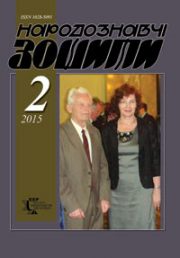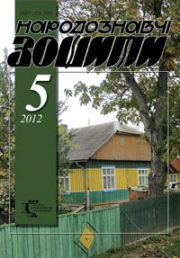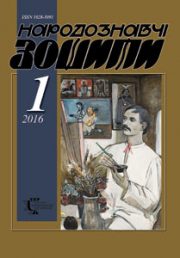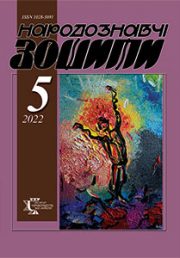The Ethnology Notebooks. 2019, 2 (146), 319—327
UDK 392+2-55 (477-1-17)
DOI https://doi.org/10.15407/nz2019.02.319
POLISSIAN BELIEFS RELATED TO BREAD: SACRAL SEMIOTIC ASPECT
TSYPYSHEV Serhii
ORCID ID: https://orcid.org/0000-0001-5924-8930
Deputy Director of Research
Museum of Folk Architecture and Rural Life in Lviv
named after Klymentii Sheptytskyi,
Chernecha Hora str., 1, 79014, Lviv, Ukraine
Contacts: e-mail: SerhiyTsypyshev@gmail.com
Abstract. Beliefs are an integral part of everyday life, besides, they often become the basis for traditional practice phenomena. Similarly, bread in folk culture is necessary part of the daily life cycle, and at the same time it is an indispensable attribute of rituals. There are many warnings and regulations around it, and extremely stable conceptions. Therefore, the wider coverage of the sacred-semiotic aspect of the beliefs associated with bread on the territories of certain ethnographic regions is relevant nowadays. In this work, the author aims to consider the beliefs of Polissia region that are related to bread, one way or another, to reveal their specificity as well as it resemblance to the whole Ukrainian context; the article also would highlight the sacred-semiotic load of bread-associated beliefs. The object of scientific exploration is beliefs of the Polischuk people, the ones that are related to the bread are its subject. Author have used methods of typological analysis and reconstruction, in combination with structural and functional elements, using the basic methods of ethnological science. The bread-associated beliefs are usually considered in conjunction with other customary actions or are briefly mentioned in the researches on baking, as well as other aspects of traditional culture. That is why the author tries to cover them as comprehensively as possible, based on his own field materials collected during the last decade on the territory of Polissia.
In analyzing the sacred-semiotic component of the above-mentioned beliefs, the author relies on the work of famous Ukrainian and foreign researchers, ethnologists and philosophers, both contemporary and those whose works have already become the classics of scientific thought. Folk bakery is soaked up by many beliefs that accompany bread from the process of making to consumption. Due to the continuity of the tradition and the preserved habit of home baking at Polissia, a great many of these custom elements have been saved and are still functioning. The main reasons for this are a certain sacralization of bread, but without its deification; as well as the direct relevance of many bread-associated customs to acts of honoring the dead ancestors, the tradition that is extremely long-standing and resistant to changes and influences. According to the author, these beliefs have become an integral part of the Polissia and All-Ukrainian tradition, one of the foundations of the social landscape of the designated territories.
Keywords: bread, Polissia, beliefs, sacredness, semiotics.
Received 25.02.2019
REFERENCES
Petrov, V. (1947). Origin of the Ukrainian people. Regensburg: USG [in Ukrainian].
Herodotus. (1993). Stories in nine books. Kyiv: Naukova Dumka [in Ukrainian].
Dovzhenok, V.Y. (1961). Agriculture of ancient Rus. Kyiv: Publishing House of the Academy of Sciences of the Ukrainian SSR [in Ukrainian].
The etymological dictionary of the Ukrainian language. (1985). (Vol. 2). Kyiv: Naukova dumka [in Ukrainian].
Artiukh, L.F. (1982). Folk nutrition of Ukrainians and Russians in the northeastern regions of Ukraine. Kyiv: Naukova Dumka [in Ukrainian].
Borenko, N. (2001). Traditional food of Polischuks of Kyiv region and some food regulations. The Ethnology Notebooks, 3 (39), 558—562 [in Ukrainian].
Herus, L. (2006). Types, forms, functions of ceremonial biscuits for the day of the forty St. Martyrs, Annunciation on Polissia (in the context of the Slavic tradition). The Ethnology Notebooks, 3—4 (69—70), 521—528 [in Ukrainian].
Kutelmakh, K. (2006). Polissia-Carpathian parallels in the all-Ukrainian calendar-ceremonial sphere. The Ethnology Notebooks, 3—4 (69—70), 328—337.
Kutelmakh, K. (1997). Memorial motives in the calendar ritual of the Polischuks. In Polissya of Ukraine: materials of historical and ethnographic research (Vol. 1: Kyiv Polissia, 1994, pp. 172—203). Lviv [in Ukrainian].
Parkhomenko, T. (2008). Calendar Manners and Rites of the Rivne region. Rivne: Publisher Oleh Zen [in Ukrainian].
Konobrodska, V. (2007). Polissian funeral and memorial ceremonies. Ethnolinguistic studios. Zhytomyr: Polissia [in Ukrainian].
Strakhov, A.B. (1991). Cult of bread from eastern Slavs. Experience of linguistic research. Munich: Verlag Otto Sagner [in Russian].
AA of the SSCPCHTD (Audio Archives of the State Scientific Center for the Protection of the Cultural Heritage from Technological Disasters). Volodarka-2012, Tsypyshev, АF-D2.S.2/05 [in Ukrainian].
AA of the SSCPCHTD. Volodarka-2012, Tsypyshev, АF-D3.S.1/26 [in Ukrainian].
Tsypyshev, S.I. (2012). Report on the mission in Kovel, Starovyzhivka and Turiisk districts of Volyn region. Archive of the MNAP (Archive of the Museum of folk architecture and rural life in Lviv named after Klymentii Sheptytskyi). F. Materials of expeditions. Exp. ЗВ-111 [in Ukrainian].
Tsypyshev, S.I., Kovalchuk, V.P. (Ed.). (2009). Varieties of bread in everyday life and ceremonies. Ethnoculture of Rivne Polissia (pp. 111—118). Rivne: PP DM [in Ukrainian].
АА of the SSCPCHTD. Volodymyrets-2009, Tsypyshev, АF-C3.S.А/01 [in Ukrainian].
АА of the SSCPCHTD. Volodymyrets-2009, Tsypyshev, АF-C8.S.B/22 [in Ukrainian].
Tsypyshev, S. (2009). Traditional bread products of Rivne Polissia on a beginning of the twentieth century. (On field materials from Dubrovytsia and Sarny districts of the Rivne region). In Polissia studies in folklore-ethnographic and literary-artistic research: Scientific publication (pp. 99—107). Rivne [in Ukrainian].
Tsypyshev, S.I. (2010). Report on the mission in Liuboml, Shatsk and Ratne districts of Volyn region. Archive of the MNAP. F. Materials of expeditions. Exp. ЗВ-106 [in Ukrainian].
Tsypyshev, S.I. (2011). Report on the mission in Kamin-Kashyrskyi, Liubeshiv and Manevychi districts of Volyn region. Archive of the MNAP. F. Materials of expeditions. Exp. ЗВ-109 [in Ukrainian].
AA of the SSCPCHTD. Yemilchyne-2011, Tsypyshev, АF-D1.S.1/24 [in Ukrainian].
АА of the SSCPCHTD. Zarichne-2010, Tsypyshev, АF-C4.S.B/22 [in Ukrainian].
AA of the SSCPCHTD. Volodarka-2012, Tsypyshev, АF-D5.S.1/15 [in Ukrainian].
АА of the SSCPCHTD. Zarichne-2010, Tsypyshev, АF-C6.S.A/02 [in Ukrainian].
AA of the SSCPCHTD. Yemilchyne-2011, Tsypyshev, АF-D8.S.1/24 [in Ukrainian].
AA of the SSCPCHTD. Yemilchyne-2011, Tsypyshev, АF-D9.S.1/20 [in Ukrainian].
AA of the SSCPCHTD. Yemilchyne-2011, Tsypyshev, АF-D10.S.4/24 [in Ukrainian].
Tsypyshev, S. (2011). Bread products in the traditional culture of Polishchuks of Zarichne region. Materials for Ukrainian ethnology, 10 (13), 147—153 [in Ukrainian].
АА of the SSCPCHTD. Zarichne-2010, Tsypyshev, АF-C4.S.A/07 [in Ukrainian].
Halaichuk, V. (2010). From the spiritual culture of Bogorodchany region: customs, beliefs and beliefs associated with ideological perceptions of death and deceased. Mythology and folklore, 3—4, 27—49 [in Ukrainian].
Busel, V.T. (Ed.). (2005). Great explanatory dictionary of modern Ukrainian language. Kyiv; Irpin: VTF Perun [in Ukrainian].
Sosenko, K. (1923). Source of Ukrainian religious worldview. Lviv: Zhyvi hroby [in Ukrainian].
Morozov, S.M., & Shkaraputa, L.M. (Eds.). (2000). Dictionary of foreign words. Kyiv: Naukova dumka [in Ukrainian].
Niderle, L. (1956). Slavic antiquities. Moscow: Publishing House of Foreign Literature [in Russian].
Veletskaya, N.N. (1978). Pagan Symbols of Slavic Archaic Rituals. Moscow: Nauka [in Russian].
Tokarev, S.A. (Ed.). (1977). Calendar customs and ceremonies in countries of foreign Europe. Spring holidays. Moscow: Nauka [in Russian].
Sosiur, F. de. (1998). Course in General Linguistics. Kyiv: Osnovy [in Ukrainian].
Peirce, Сh.S. (2000). Logical Foundations of the Theory of Signs. St. Petersburg: Aleteyya [in Russian].
Phylypchuk, H. (2016). Heathen burial monuments of VIII—XII centuries in the watershed of Western Bug and Upper Prut. The Ethnology Notebooks, 4 (130), 929—940 [in Ukrainian].
Summary of the most ancient written news about the Slavs. (1991). (Vol. 1). Moscow: Nauka [in Russian].
Fedorov, N.F. (1906). Philosophy of the common cause (Vol. 1). Semirechensk: Vernyi [in Russian].
Cunow, H. (1922). Origin of religion and the faith of God. Kyiv; Berlin: Znattia to syla [in Ukrainian].
Willaime, J.-P. (2006). Europe and religions. Kyiv: Dukh i litera [in Ukrainian].
Propp, V.Ya. (1946). Historical roots of the fairy tale. Leningrad: Publishing house of LSU [in Russian].
Levy-Bruhl, L. (1994). The supernatural and the natural in the primitive mentality. Moscow: Pedagogika-Press [in Russian].







